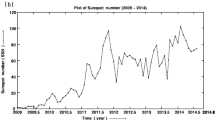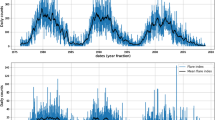Conclusions
The following facts emerge from the study:
-
1)
In general there is a negative correlation betweenI, the cosmic ray intensity, andK bp the planetary index, although there are exceptions.
-
2)
There is a positive correlation between the relative decrease in intensity, —I/It and the planetary index,K bp. There are exceptions during the low sunspot activity period of 1949 ÷ 54.
-
3)
TheK bp minimum (or maximum) is observed to precede the corresponding cosmic ray one in some years and follow in other years. But it appears that the latter case is generally found during the rising part of the solar cycle and possibly during the early fall.
-
4)
There is clear evidence that the amplitude of the 27 day variation in cosmic ray intensity follows the geomagnetic disturbance better than the solar activity. Both of them exhibit similar departure from solar activity during 1946 ÷ 52.
-
5)
The time of maximum of the diurnal variation of cosmic ray intensity on disturbed days follows the geomagnetic disturbance better than the solar activity. The semidiurnal time of maximum on disturbed days appears to follow the solar activity in a rough measure.
Similar content being viewed by others
References
S. Forbush:Phys. Rev.,52, 1254 (1937).
V. F. Hess andA. Demmelmair:Nature,140, 316 (1937).
A. R. Hogg:Memoirs of the Commonwealth Observatory, Canberra, No. 10 (1949).
Y. Sekido, M. Wada, I. Kondò andK. Kawabata:Rep. Ion. Res. Japan,9, 174 (1956).
S. Yoshida:Nuovo Cimento,4, 1410 (1956).
J. A. Simpson:Phys. Rev.,94, 426 (1954).
R. L. Chasson:Phys. Rev.,96, 1117.
D. W. N. Dolbear andH. Elliot:Nature,159, 58 (1947).
B. Trumpy:Physica,19, 645 (1953).
R. P. Kane:Phys. Rev.,98, 130 (1955).
V. Heerdan andThambyah Pillai:Phil. Mag.,46, 1238 (1955).
D. Venkatesan:International Astronomical Union Conference on Electromagnetic Phenomena in Cosmical Physics (1956).
Carnegie Institution Publication:Cosmic Ray Results from Huancayo Observatory, Publication 175 (1948).
H. Alfvén:Cosmical Electrodynamics (Oxford, 1950), Chap. VI;
H. Alfvén:Tellus,6, 232 (1954).
H. Alfvén:Tellus,7, 50 (1955).
H. Alfvén:International Astronomical Union Conference on Electromagnetic Phenomena in Cosmical Physics (1956).
D. Venkatesan:Tellus, Awaiting publication (1957).
P. Meyer andJ. A. Simpson:Phys. Rev.,96, 1085 (1954).
V. Sarabhai, U. D. Desai andD. Venkatesan:Phys. Rev.,96, 469 (1954).
Author information
Authors and Affiliations
Rights and permissions
About this article
Cite this article
Venkatesan, D. The 27-day variation in cosmic ray intensity. Nuovo Cim 8 (Suppl 2), 285–297 (1958). https://doi.org/10.1007/BF02962537
Published:
Issue Date:
DOI: https://doi.org/10.1007/BF02962537




